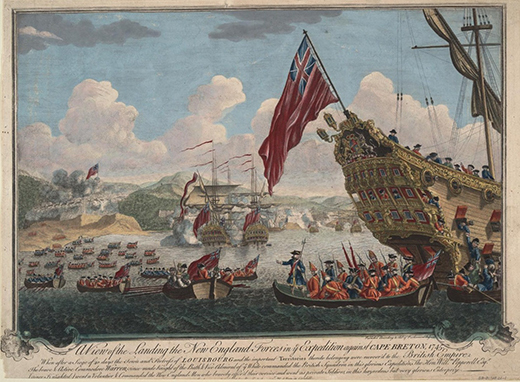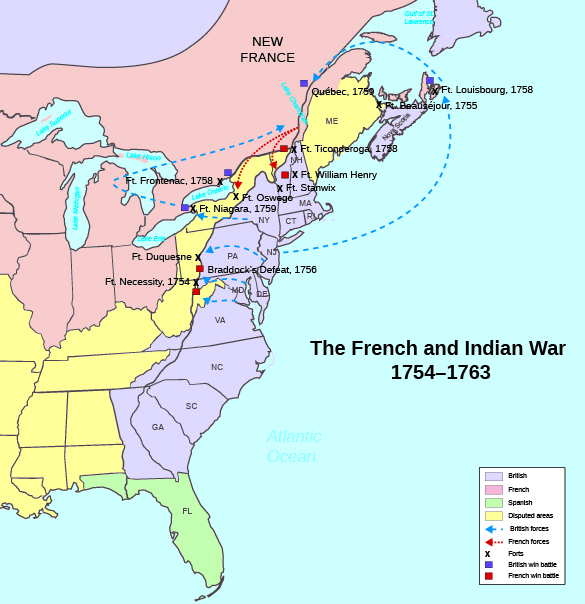| << Chapter < Page | Chapter >> Page > |
In North America, possession of Georgia and trade with the interior was the focus of the War of Jenkins’ Ear (1739–1742), a conflict between Britain and Spain over contested claims to the land occupied by the fledgling colony between South Carolina and Florida. The war got its name from an incident in 1731 in which a Spanish Coast Guard captain severed the ear of British captain Robert Jenkins as punishment for raiding Spanish ships in Panama. Jenkins fueled the growing animosity between England and Spain by presenting his ear to Parliament and stirring up British public outrage. More than anything else, the War of Jenkins’ Ear disrupted the Atlantic trade, a situation that hurt both Spain and Britain and was a major reason the war came to a close in 1742. Georgia, founded six years earlier, remained British and a buffer against Spanish Florida.
King George’s War (1744–1748), known in Europe as the War of Austrian Succession (1740–1748), was fought in the northern colonies and New France. In 1745, the British took the massive French fortress at Louisbourg on Cape Breton Island, Nova Scotia ( [link] ). However, three years later, under the terms of the Treaty of Aix-la-Chapelle, Britain relinquished control of the fortress to the French. Once again, war resulted in an incomplete victory for both Britain and France.

The final imperial war, the French and Indian War (1754–1763), known as the Seven Years’ War in Europe, proved to be the decisive contest between Britain and France in America. It began over rival claims along the frontier in present-day western Pennsylvania. Well-connected planters from Virginia faced stagnant tobacco prices and hoped expanding into these western lands would stabilize their wealth and status. Some of them established the Ohio Company of Virginia in 1748, and the British crown granted the company half a million acres in 1749. However, the French also claimed the lands of the Ohio Company, and to protect the region they established Fort Duquesne in 1754, where the Ohio, Monongahela, and Allegheny Rivers met.
The war began in May 1754 because of these competing claims between Britain and France. Twenty-two-year-old Virginian George Washington, a surveyor whose family helped to found the Ohio Company, gave the command to fire on French soldiers near present-day Uniontown, Pennsylvania. This incident on the Pennsylvania frontier proved to be a decisive event that led to imperial war. For the next decade, fighting took place along the frontier of New France and British America from Virginia to Maine. The war also spread to Europe as France and Britain looked to gain supremacy in the Atlantic World.
The British fared poorly in the first years of the war. In 1754, the French and their native allies forced Washington to surrender at Fort Necessity, a hastily built fort constructed after his attack on the French. In 1755, Britain dispatched General Edward Braddock to the colonies to take Fort Duquesne. The French, aided by the Potawotomis, Ottawas, Shawnees, and Delawares, ambushed the fifteen hundred British soldiers and Virginia militia who marched to the fort. The attack sent panic through the British force, and hundreds of British soldiers and militiamen died, including General Braddock. The campaign of 1755 proved to be a disaster for the British. In fact, the only British victory that year was the capture of Nova Scotia. In 1756 and 1757, Britain suffered further defeats with the fall of Fort Oswego and Fort William Henry ( [link] ).

The war began to turn in favor of the British in 1758, due in large part to the efforts of William Pitt, a very popular member of Parliament. Pitt pledged huge sums of money and resources to defeating the hated Catholic French, and Great Britain spent part of the money on bounties paid to new young recruits in the colonies, helping invigorate the British forces. In 1758, the Iroquois, Delaware, and Shawnee signed the Treaty of Easton, aligning themselves with the British in return for some contested land around Pennsylvania and Virginia. In 1759, the British took Quebec, and in 1760, Montreal. The French empire in North America had crumbled.
The war continued until 1763, when the French signed the Treaty of Paris . This treaty signaled a dramatic reversal of fortune for France. Indeed, New France, which had been founded in the early 1600s, ceased to exist. The British Empire had now gained mastery over North America. The Empire not only gained New France under the treaty; it also acquired French sugar islands in the West Indies, French trading posts in India, and French-held posts on the west coast of Africa. Great Britain’s victory in the French and Indian War meant that it had become a truly global empire. British colonists joyously celebrated, singing the refrain of “Rule, Britannia! / Britannia, rule the waves! / Britons never, never, never shall be slaves!”
In the American colonies, ties with Great Britain were closer than ever. Professional British soldiers had fought alongside Anglo-American militiamen, forging a greater sense of shared identity. With Great Britain’s victory, colonial pride ran high as colonists celebrated their identity as British subjects.
This last of the wars for empire, however, also sowed the seeds of trouble. The war led Great Britain deeply into debt, and in the 1760s and 1770s, efforts to deal with the debt through imperial reforms would have the unintended consequence of causing stress and strain that threatened to tear the Empire apart.
From 1688 to 1763, Great Britain engaged in almost continuous power struggles with France and Spain. Most of these conflicts originated in Europe, but their engagements spilled over into the colonies. For almost eighty years, Great Britain and France fought for control of eastern North America. During most of that time, neither force was able to win a decisive victory, though each side saw occasional successes with the crucial help of native peoples. It was not until halfway through the French and Indian War (1754–1763), when Great Britain swelled its troops with more volunteers and native allies, that the balance of power shifted toward the British. With the 1763 Treaty of Paris, New France was eliminated, and Great Britain gained control of all the lands north of Florida and east of the Mississippi. British subjects on both sides of the Atlantic rejoiced.

Notification Switch
Would you like to follow the 'U.s. history' conversation and receive update notifications?